Despite their untimely first win of the season against the Philadelphia Flyers on Monday night, the 4-3 overtime affair was a good indicator of exactly what the Arizona Coyotes currently are as a team. They seem to look for ways to lose, as evidenced by their determined effort to give up a two-goal lead in the last minute of the third period to force overtime. It almost worked but for a beautiful overtime setup by overshadowed rookie Clayton Keller (more about him later, again—overshadowed!)
So, let’s open the books and dig in, shall we? Actually, wait! Before we go in depth, let’s first define what it is we are looking to answer here.
This is basically an assets and liabilities report, if we are going to use accounting terms. Questions we hope to find answers to include:
- How did all of this mess begin? A historical retrospective that will delineate as clearly as possible the route taken by the Arizona Coyotes to the bottom half of mediocrity as an NHL franchise.
- Where do things stand presently? An inventory of team assets as we look towards a forward-thinking plan to breathe some pride back into this franchise!
- What is a reasonable timeframe for repair and what are the beginning steps? A “realistic fantasy” GM’s look at how things have to unfold for the Coyotes to become a perennial contender!
So, without further ado…
Jets Land in Arizona
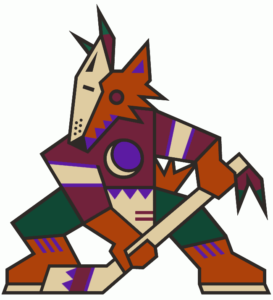
The year is 1996, and an infrastructurally struggling Winnipeg Jets franchise ironically finds itself relocated to Arizona, on Canada Day, and in the process, changing its name to the “Phoenix Coyotes”.
When the team arrived in Phoenix, it was a competitive group, featuring the likes of Keith Tkachuk, Shane Doan, Oleg Tverdovsky, Rick Tocchet and newly-acquired superstar Jeremy Roenick. The club also added Mike Gartner from the Toronto Maple Leafs and had one of the league’s best goaltenders in Nikolai Khabibulin (a.k.a., The Bulin Wall).
This may not have been a powerhouse team, but certainly was relevant annually in playoff discussions (they made it five of six years after relocation). The ownership group, however, found that their pockets were not deep enough to sustain the franchise, and thus began the merry-go-round of owners. This continued up to trucking mogul Jerry Moyes, who declared bankruptcy in 2009 after a long, well-publicized financial flushing that forced the league to take ownership rather than collapse the franchise or relocate it for a second time.
On Jan. 29, 2014, a new ownership group [Renaissance Sports and Entertainment (RSE)] announced that the team would change its name to the “Arizona Coyotes” for the 2014–15 season. According to Coyotes President Anthony LeBlanc, the change [was] made to reflect that the team [was] no longer located within Phoenix city limits (they are located in Glendale) and to include all hockey fans in the state of Arizona.
It should be noted that the then-Atlanta Thrashers were also in financial (and fanbase) turmoil around this time and were eventually relocated to become the new incarnation of the – you guessed it – Winnipeg Jets in time for the 2011-12 season.
The ownership situation created a less-than-ideal situation for the club in terms of everything from drafting to free agency, due in large part to the ownership “void.” Every avenue was exhausted, including a stint for part-owner Wayne Gretzky as a figurehead coach, but slowly and gradually, the depth of talent on the Coyotes was depleted and they became a rebuilding team. In fact, it feels as though this team has been rebuilding for the better part of a decade, if not longer.
The Coyotes are stuck in a vicious cycle—never quite bad enough to garner the top picks, nor good enough to play in the extended version of an NHL season to collect some much-needed playoff revenues. While they amassed depth in the youth department, they often ended up with non-franchise-type players, but those form the majority of NHL players, so how they develop their young assets becomes paramount.
So, we come to today’s version of the team, and where do we stand?
BREAKING: While there has been no official report on this matter, Sportsnet insider Nick Kypreos is reporting that there are now serious financial concerns regarding the Arizona Coyotes, and more specifically their owner Andrew Barroway.
“A lot of people questioning his sustainability,” said Kypreos during a Sportsnet broadcast.
While it appears that Barroway is clearly invested in the team given that he bought out all of his partners over the last year to become the team’s sole owner, Kypreos believes he is bleeding cash. “Was described to me as massive losses in Arizona.”
It’s unclear what the next step is here, however Kypreos went so far as to say that there is now concern that Barroway will be unable to last the remainder of this season as the sole owner of the team. This could mean a drastic change in ownership or perhaps even a drastic change for the Coyotes franchise moving forward.
SOURCE: HockeyFeed.com
In the Coyotes’ Den Right Now
A quick look at the roster shows that this Coyotes team is not as bad as many might think if you look specifically at talent levels. Players like Christian Dvorak, Max Domi, Clayton Keller, Oliver Ekman-Larsson and Jakob Chychrun are all top-level youngsters who may or may not have seen NHL action on any other team. The fact is that Arizona did not have the luxury of slowly immersing its prospects into the NHL, but rather had to fast-track many of them just to ice a “competitive” product.
Gone is the reliable goaltending of Khabibulin (and more recently, Mike Smith), replaced by Antti Raanta, who promptly bowed out with an injury only three games into his tenure in the Yotes’ starting role. Gambling on a repeat, Raanta was acquired in a trade with the New York Rangers, where he had just completed a very successful season as the backup to “King” Henrik Lundqvist.
Cam Talbot was a feel-good story last season with Edmonton, so the logic was air-tight, right? The answer is still blowing in the wind, as nothing is for certain without a bigger sample size of Raanta’s work as a starter, but I wouldn’t bet my last dollar on it working out. Call me a skeptic, but I think having Connor McDavid on your team tilts things slightly in your favour if you’re Cam Talbot!
The ‘Yotes also nabbed center Derek Stepan from the Rangers, and the total package was landed for the low cost of a first-round pick (used to draft Lias Andersson) and Anthony D’Angelo (a first-round pick in his own right).
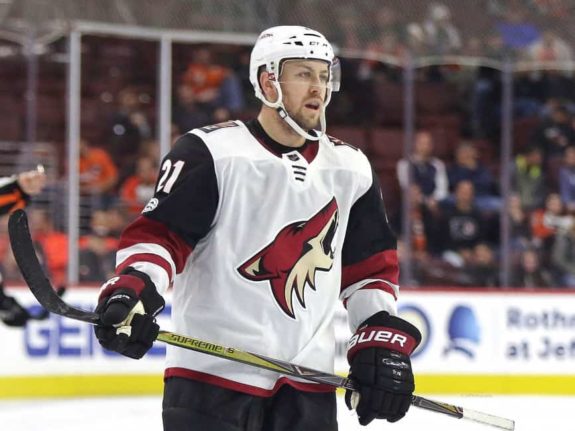
News flash – Derek Stepan is not a number-one center! I’ve been saying it for years; he’s a good second-liner, nothing more. Just because he was the best center on the Rangers doesn’t qualify him as the best center in the NHL.
But, a team with assets can always turn things around with proper asset management. So, let’s break things down into two groups:
Core Players: These players are basically “untradeable” for the Coyotes moving forward. Simply, they represent the foundation of the team, and would only be moved in a ridiculously imbalanced trade.
—and—
Transition Players: These guys include players who are good enough to temporarily play on the NHL roster but could also be swapped out for assets that better conform to the new blueprint.
The Core Coyotes
Clayton Keller (20) – C/RW: The seventh overall pick in 2016, Keller has flown under the radar for the most part, largely because of the team he plays for. With 15 points (nine goals and six assists) in 13 games, Keller is showing that good things come in small packages.
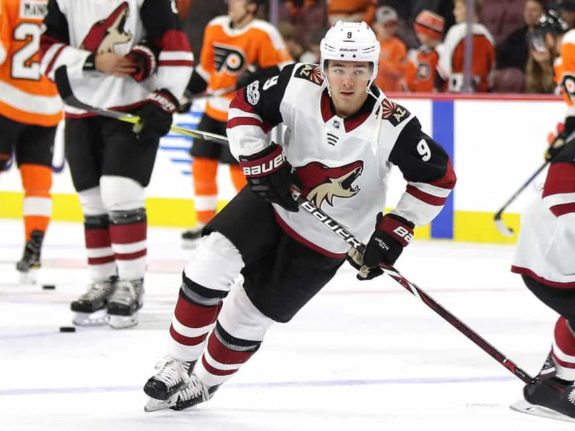
His minus-9 rating sadly demonstrates how bad this team is five-on-five, as only three of his total points have come with the man-advantage. A diminutive 5-foot-10 and 170 pounds, THW’s Dennis Schellenberg, in his pre-draft scouting report, compared Keller to Patrick Kane in terms of his ability to stay on the puck.
If he can bulk up a little bit, for the sake of durability, Keller has every chance of becoming the face of the franchise, a huge hole to fill following Shane Doan. While it is too early to say for sure, Keller may be the most skilled player to come through this franchise since Teemu Selanne. He can score, is a premier setup man, and has an innate understanding of relational position on the ice.
At this stage of his career, health is the primary concern, and making sure the exuberance of youth doesn’t put him in harm’s way unnecessarily. It is hard to say if the wingers he needs to eventually become the top pivot can be established from within by trying different combinations, and this season is a perfect season to write off and tinker.
Max Domi (22) – LW: The young Domi is an offensive cog in the ‘Yotes attack. He has soft hands, good hockey instincts and an overall skill set that clearly separates him from his father, Tie Domi. He has decent speed and is a smart skater who isn’t afraid to go into the nasty spots for deflections and screens. Look for him to be part of the template used as we theoretically rebuild this team!
Christian Dvorak (21) – C: Dvorak has all the tools to be an above-average second-line center, or possibly even a workable number-one. He has yet to fully develop physically, and as he adds strength he has to watch the balance between strength and speed. He should only improve as the team begins to round out its roster depth in order to make it more difficult to line-match.
Related: Dvorak, Domi Among Forwards Trending Up in Arizona
Jakob Chychrun (19) – D: Drafted to hit his prime as Oliver Ekman-Larsson falls out of his, Chychrun has already suffered a major injury to his knee and had surgery this offseason to repair it, and that has him missing games as we speak. As he recovers, we’ll look back at the seven goals and 20 points he had last year in 68 games, and suggest this kid will be something as good as, if not better than, OEL. There will come a point where it is critical mass for the two defencemen and they are both in their prime, and that will be something special!

Oliver Ekman-Larsson (26) – D: Right now, he is the only player I would call a “star” on this Arizona roster. OEL is overlooked by many but has become one of the premier defencemen in the NHL. Playing for recent editions of the Coyotes simply makes statistical greatness impossible for blueliners, so having two 20-plus goal seasons is really something. His categorization comes with the caveat that other things work out in the first offseason of this theoretical exercise – certain trades, picks or pickups have to sort out properly for him to even be remotely available.
Other (Movable) Coyotes Assets
Anthony Duclair (22) – LW: Duclair could become the team’s most natural goal-scoring threat if his development goes ideally. Acquired from the Rangers for Keith Yandle a couple of years ago, he has yet to really produce at the level scouts expected, but he does play a passable two-way game and seems like a very coachable player.
Christian Fischer (20) – RW: Fischer has the skill to become a threat on the power play. I don’t think he’ll evolve into a true first-liner, but he can patch that role for a season or two if needed. As with a lot of the youth, he needs to mature into his body and adapt his game accordingly. One easily-coached element he needs to work on is quickening up his release. He is accurate and gets a lot of looks, but a hesitant trigger finger is costing him production, even from the third line.
Derek Stepan (27) – C: Stepan, as I said, is not a number-one center, nor can he become one. All his role implies is that there is nobody better on the roster, and often that is telling. Stepan can play veteran in Arizona, at least for now, but if the team can get something meaningful in return, like a second-round pick plus something else, it wouldn’t be cataclysmic to wave goodbye to Stepan.
Niklas Hjalmarsson (30) – D: A useful piece to keep things stable through the rebuilding process. Hjalmarsson is the elder statesman moving forward and provides a veteran presence that will prove invaluable as the kids grow into more prominent roles.
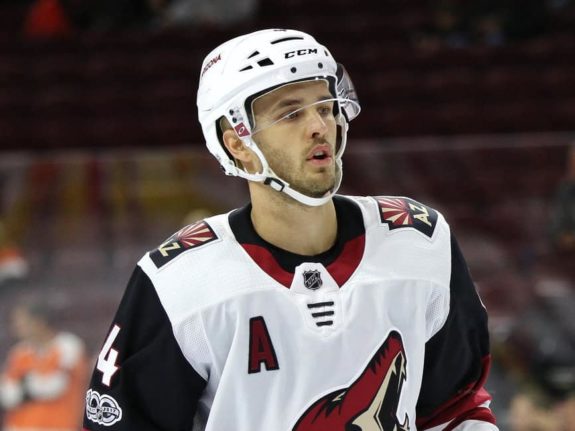
Jason Demers (29) – D: Exiting his prime, Demers does bring some power-play experience as well as decent puck-moving ability. He isn’t really a top-four guy, but used in tandem with a speedier young partner, he can be effective in transition.
Luke Schenn (28): D: nobody really knows what happened to Luke Schenn since he left Toronto. Formerly viewed as one of the top defensive prospects in hockey, Schenn never seemed to find a definite role on either the Leafs or the Flyers and not even the Kings, where he spent one season before coming to Arizona. Never an offensively productive player, one looks to his plus/minus of minus-9 last year and it doesn’t seem that he contributes much defensively either. And yet, I wouldn’t necessarily usher him out of town just yet.
Consideration has to be given to players currently toiling for the AHL’s Tuscon Roadrunners, such as former first-rounders Dylan Strome (Arizona – third overall in 2015), Emerson Etem (Anaheim – 29th in 2010), Nick Merkley (Arizona – 30th in 2015), Lawson Crouse (FLA – 11th in 2015) and Pierre-Olivier Joseph. Along with a few second-round selections (as far down in the draft as I can project NHL-readiness and likelihood of promotion), the Coyotes have enough in the pipeline to consider dealing some young players for established players who fill specific roles and have already proven their aptitude in those areas.
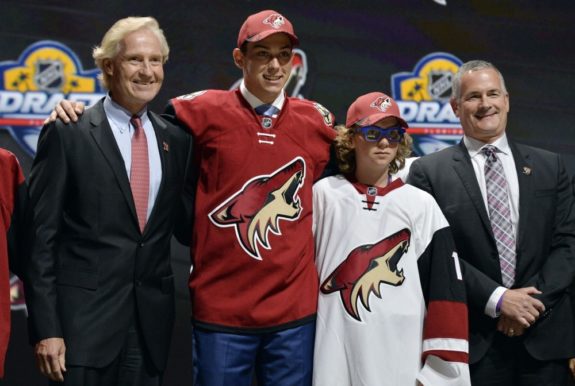
For example, you could consider trading Max Domi, but only for a starting goaltender between the ages of 24 and 28 with at least one year of playoff experience, like Martin Jones. While still highly unlikely, in this case on both ends of the trade, it is that type of deal the Coyotes will have to consider, and even look for, as they move forward.
Adding draft picks along the way would ultimately prove useful in assuring there isn’t another major downward spiral in the near future for a team and fanbase who are likely sick of the word “rebuild” by now!
Arizona’s Positional Weaknesses
The Arizona Coyotes have some strength up front, with a lot of hope abound that Clayton Keller will develop into a premier top-line center. They have some interesting pieces to work with on the offensive side of the team, and trying various combinations will separate the wheat from the chaff. Where they really need to focus is the back end, most notably the starting goaltender’s role.
While free agency or a trade might be the most instant way to accomplish this goal, enticing someone to be the starting goalie in Arizona might be a tough sell unless the other ducks are in a row. So, bulking up the defence behind the top-two pairing of Chychrun and Ekman-Larsson will be imperative, all the while trying desperately to find a netminder that even shows grooming potential.
Louis Domingue wasn’t the answer. Antti Raanta might be, but injury issues complicate what we can expect. Scott Wedgewood and Hunter Miska are the current backups, and Miska, at least, hasn’t had an NHL shot yet. But, reality dictates that this change will come from outside the Coyotes’ organization.
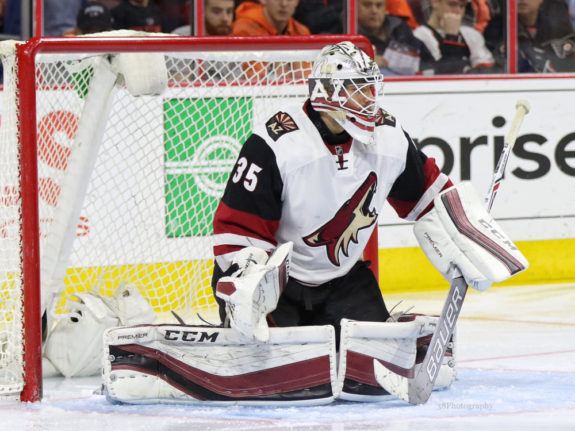
With all of this in mind, what would be realistic in terms of a timeframe to turn this thing around? It is a bare-bones core group, but the ages are good for a retooling. Most of these young guys will hit their prime at the same time, so a properly managed rebuild, both from a talent and salary-cap perspective, could be done in as few as three cycles (season + free agency + draft = 1 cycle). Given the starting point, tangible results in this hypothetical scenario should be seen rather quickly.
So, we’ve broken down the current assets and outlined what is needed to turn this franchise into a perennial playoff team as best as we could to this point. I’ll be posting more stories about these underDOGS soon.
With notes from Wikipedia